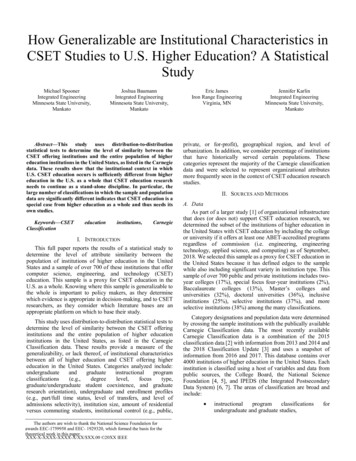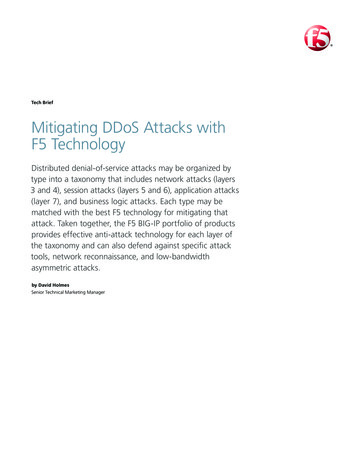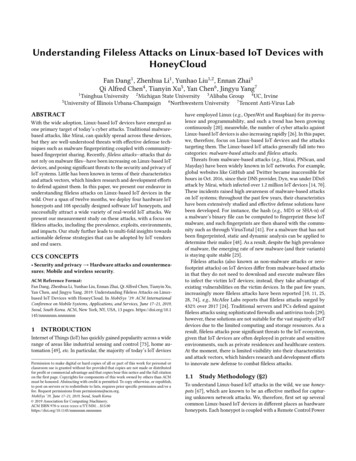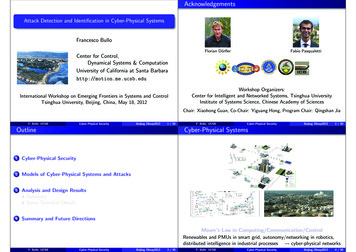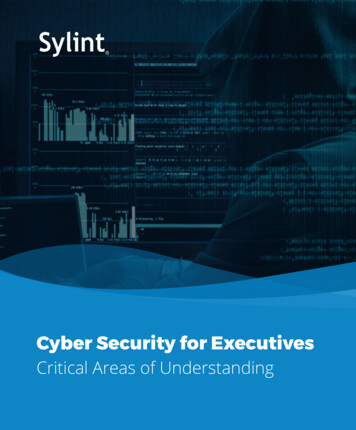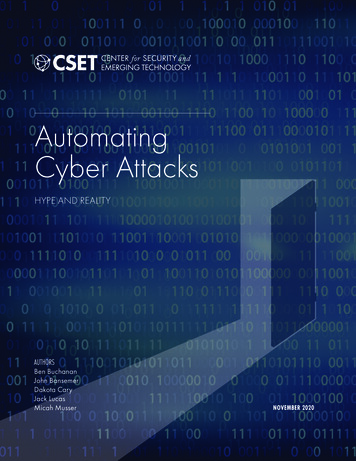
Transcription
AutomatingCyber AttacksHYPE AND REALITYAUTHORSBen BuchananJohn BansemerDakota CaryJack LucasMicah MusserNOVEMBER 2020
Established in January 2019, the Center for Security andEmerging Technology (CSET) at Georgetown’s WalshSchool of Foreign Service is a research organization focused on studying the security impacts of emerging technologies, supporting academic work in security and technology studies, and delivering nonpartisan analysis to thepolicy community. CSET aims to prepare a generation ofpolicymakers, analysts, and diplomats to address the challenges and opportunities of emerging technologies. Duringits first two years, CSET will focus on the effects of progressin artificial intelligence and advanced computing.CSET.GEORGETOWN.EDU CSET@GEORGETOWN.EDU2Center for Security and Emerging Technology
NOVEMBER 2020AutomatingCyber AttacksHYPE AND REALITYAUTHORSBen BuchananJohn BansemerDakota CaryJack LucasMicah Musser
ACKNOWLEDGMENTSThe authors would like to thank Perri Adams, Max Guise, DrewLohn, Igor Mikolic-Torreira, Chris Rohlf, Lynne Weil, and AlexandraVreeman for their comments on earlier versions of this manuscript.PRINT AND ELECTRONIC DISTRIBUTION RIGHTS 2020 by the Center for Security and Emerging Technology.This work is licensed under a Creative Commons AttributionNonCommercial 4.0 International License.To view a copy of this license, .0/.Document Identifier: doi: 10.51593/2020CA002Cover photo: KsanaGraphica/ShutterStock.
ContentsEXECUTIVE SUMMARYIIIINTRODUCTIONV1 THE CYBER KILL CHAIN12 HOW MACHINE LEARNING CAN (AND CAN’T)CHANGE OFFENSIVE OPERATIONS113 CONCLUSION: KEY JUDGMENTS21ENDNOTES29Center for Security and Emerging Technologyi
ivCenter for Security and Emerging Technology
Executive SummaryHacking is a well-established part of statecraft. Machine learningis rapidly becoming an arena of competition between nationsas well. With the continued importance of computer hackingand the increasing drumbeat of AI advances due to machine learning,important questions emerge: what might machine learning do for cyberoperations? How could machine learning improve on the techniques thatalready exist, ushering in faster, stealthier, and more potent attacks? Onthe other hand, how might its importance to cyber operations be misleadingly overhyped?We examine how machine learning might—and might not—reshapethe process of launching cyber attacks. We examine the cyber kill chainand consider how machine learning could enhance each phase of operations. We expect certain offensive techniques to benefit from machinelearning, including spearphishing, vulnerability discovery, deliveringmalicious code into targeted networks, and evading cyber defenses. However, we caution that machine learning has notable limitations that are notreflected in much of the current hype. As a result of these constraints andflaws, attackers are less likely to apply machine learning techniques thanmany expect, and will likely do so only if they see unique benefits. Ourcore conclusions are: Current cyber automation techniques are powerful and meet theobjectives of many attackers. For most attackers, they will not havean obvious need to augment their operations with machine learning, especially given the complexity of some machine learningtechniques and their need for relevant data. If current methods ofautomation become less effective or machine learning techniquesbecome more accessible, this may change.Center for Security and Emerging Technologyiii
In the near term, machine learning has the potential to increase both thescale and success rate of spearphishing and social engineering attacks. Of the machine learning techniques reviewed in this paper, reinforcementlearning promises the most operational impact over the medium-to-longterm. Though its potential impact is speculative, it could reshape how attackers plan and execute cyber operations. Machine learning systems have substantial limitations, such as their relianceon salient data, their weakness to adversarial attacks, and their complexityin deployment. Like other cyber capabilities, many machine learning capabilities are inherently dual-use, with the advantage accruing to those who have the resources and expertise to use them best rather than always favoring attackers ordefenders.The paper proceeds in three parts. The first part covers the state of the art incyber operations today, showing how attackers progress through the kill chain andtaking care to demonstrate how traditional automation assists them in their efforts.The second part considers machine learning in more depth, exploring its differencesfrom traditional automation and probing how those differences might—and mightnot—reshape key parts of the kill chain. Among other things, it highlights the way inwhich machine learning could improve discovery of the software vulnerabilities thatenable cyber operations, grow the effectiveness of spearphishing emails that delivermalicious code, increase the stealthiness of cyber operations, and enable maliciouscode to function more independently of human operators. The conclusion takesstock, drawing out key themes of geopolitical and technical importance. It arguesthat machine learning is overhyped and yet still important, that structural factors willlimit the relevance of machine learning in cyber operations for most attackers, thatthe dual-use nature of cyber operations will continue, and that great powers—including the United States—should be proactive in exploring how machine learningcan improve their operations.ivCenter for Security and Emerging Technology
IntroductionThe use of a computer at Lawrence Berkeley Laboratory in 1986 cost 300 per hour.1 One day, when reviewing the accounting ledgers,a system administrator discovered a seventy-five-cent discrepancy.The administrator asked another staffer, Clifford Stoll, to investigate. Whatfollowed was one of the first and most well-documented hunts for a cybercriminal. Stoll, in his classic book The Cuckoo’s Egg, details a case studyin persistence on the part of both the attacker and the defenders that, fromtoday’s vantage point, seems to develop in slow motion.This attack was not a highly automated quick strike. Instead, it unfoldedover the course of months. The attack techniques, directed from a computerhalfway around the world, were manual and relatively unsophisticated,yet effective. This slow pace and lack of automation is not surprising. Theinternet at the time had about 20,000 connected computers, transmissionspeeds were measured in kilobytes, and computing power was a fractionof what is available on today’s mobile devices.The attacker followed an operational process, or kill chain, that haslargely endured: reconnaissance, initial entry, exploitation of known vulnerabilities, establishment of command and control channels, and lateralmovement across networks. Each of these steps contributed to the ultimateobjective of exfiltrating sensitive documents from defense contractors,universities, and the Pentagon.2 With striking simplicity, the attacker attempted logging onto systems with known account names and commonlyused passwords, such as “guest.” Even with this rudimentary technique, theattacker gained unauthorized access upwards of 5 percent of the time.3While the attack was largely manual, automation aided the defenders. Stoll and others established automated systems to alert them when theCenter for Security and Emerging Technologyv
attacker accessed key machines and networks, enabling the team to begin tracingthe ultimate source of the attacks. Sometimes with the help of court orders and telephone companies, the defenders systematically worked back through the tanglednetwork of infected computers toward the attacker. Stoll and his team baited theattacker with enticing (but fake) files related to the highly sensitive Strategic DefenseInitiative—the rough equivalent of Cold War catnip.4 The attacker spent so muchtime online examining the bogus files that technicians were able to trace the intruder’s location: Hanover, Germany. Local authorities eventually charged Markus Hessand four of his German associates with espionage for their various roles in feedingpilfered documents and network details to the Soviet security agency then known asthe KGB.About a year later, Stoll received an alarming call about a new threat: an automated attack was cascading across the internet, digitally destroying everything in itspath. Stoll and other computer security experts raced to stop the self-propagatingcode, which became known as the Morris Worm. They succeeded, but not beforethe worm disabled more than 2,000 computers in the span of 15 hours.5 This attackstood in sharp contrast to the manual operations of the period and introduced theconcept of automated cyber attacks.The two cases neatly bookend the spectrum of conceptual possibilities whenit comes to cyber operations. On one end are the plodding manual efforts, painstakingly carried out by attackers and thwarted by system administrators and theirtools in a cat-and-mouse game that unfolds over months. On the other end are theautomated attack sequences—often lacking nuance or control—that tear across theinternet at high speed and destroy everything in their path. Operations at both endsof the spectrum continue today, though human-directed efforts benefit from moreautomation and automated attacks exhibit greater control than before.In this context arrives machine learning, a technology at the core of almostall the hype surrounding AI today. Within the last decade, machine learning hasachieved technical feats that were not too long ago thought to be decades or evencenturies away. Machine learning algorithms have beaten world champion playersat fiendishly complex board and video games, demonstrating something akin tointuition. These algorithms have devised convincing photos and videos of peoplewho never existed, painted compelling portraits, and written music and stories sogood that they seem humanlike in their creativity. They have done so with rapidlyincreasing speed and quality, charting a growth curve in capabilities that seems topoint ever upward.Against this backdrop of advances, important questions emerge: what mightmachine learning do for cyber operations? How could the improved automationviCenter for Security and Emerging Technology
technology improve on the techniques that already exist, ushering in faster, stealthier, and more potent attacks? On the other hand, how might it be misleadinglyoverhyped?In this paper, we tackle these questions. To do so, we proceed in three parts. Thefirst part covers the state of the art in cyber operations today, showing how attackersprogress through the kill chain and taking care to demonstrate how traditional automation assists them in their efforts. The second part considers machine learning inmore depth, exploring its differences from traditional automation and probing howthose differences might—and might not—reshape key parts of the kill chain. Amongother things, it highlights the way in which machine learning could improve discovery of the software vulnerabilities that enable cyber operations, grow the effectiveness of spearphishing emails that deliver malicious code, increase the stealthinessof cyber operations, and enable malicious code to function more independently ofhuman operators.The conclusion takes stock, drawing out key geopolitical and technicaljudgments. It argues that machine learning is overhyped and yet still important, thatstructural factors will limit the relevance of machine learning in cyber operations formost attackers, that reinforcement learning techniques show promise in the mediumto-long term, that the dual-use nature of cyber operations will continue, and thatgreat powers—including the United States—should be proactive in exploring howmachine learning can improve their operations.Center for Security and Emerging Technologyvii
12Center for Security and Emerging Technology
1The Cyber Kill ChainThe kill chain is an established method of conceptualizing cyber operations by presenting a checklist of tasks that attackerswork through on their way to their objective. Lockheed Martinresearchers published a canonical paper outlining the idea in 2010.6Other organizations, such as MITRE, have introduced more complexversions.7 While the kill chain model has limitations—such as portrayingcyber operations as overly linear—it is a common and useful way tobegin to understand cyber attacks. We therefore use it as a foundation toexplore how cyber operations work and how automation that does notuse machine learning aids attackers; this is the status quo that machinelearning-enabled automation seeks to advance.Attackers will perform some or all of the kill chain’s steps. Dependingupon their overall objective, attackers may merge several steps by employing commonly used exploit tools or techniques. Each step they executerepresents an opportunity for a defender to stop an attack. We discuss sixsteps widely agreed to be important: reconnaissance, weaponization, delivery, command and control, pivoting, and actions on objective. Each stepconstitutes its own processes, challenges, and techniques—all of whichcontinue to evolve, including with greater automation.This section illustrates well-known cases of each step of the kill chainand current state-of-the-art techniques. Readers familiar with the cyber killchain and how automation helped enable major operations—especiallyNotPetya, CRASHOVERRIDE, Agent.BTZ, Conficker, and the 2015 Ukraineblackout—should feel free to skip ahead to our discussion of machinelearning in the following section.Center for Security and Emerging Technology1
RECONNAISSANCEAttackers must first pick their target. Their process of reconnaissance and targetselection depends on the objectives. Some attackers will be interested in infectingbroad categories of users and will largely forego this process. Others are moreselective in their choice of victims, requiring a more extensive reconnaissanceeffort. In this phase, attackers first identify humans and machines that are worthtargeting and then gather information about the technical vulnerabilities of thosetargets.To inform their search for human targets, attackers can gather important detailsabout an organization and its personnel through internet searches, social mediaanalysis, and scraping technical online forums. These passive techniques have theadded advantage of being largely undetectable. Traditional techniques of automation offer a means to collect, sort, and analyze data collected in this way, significantly shortening time spent in this phase and helping attackers plot their next move.Such techniques may be augmented with fairly simple machine learning-enabledmethods to identify the victims most susceptible to a variety of social engineeringtechniques.To inform their search for machine targets, attackers can use more active techniques, such as automated scanners that probe target networks for details on theirconnected systems, network defenses, and associated software configurations.Available since the late 1990s, nmap is a popular, freely available, automatedtool that has evolved to include new functionalities and user interfaces, enablingattackers to remotely gain more information about their potential targets and moreeasily interpret the results.8 This kind of active reconnaissance is extremely common,and most devices on the internet are constantly being scanned by a wide variety ofmalicious actors, many of whom are looking for vulnerabilities to exploit.WEAPONIZATIONWith their targets identified, attackers have to discover and exploit technicalweaknesses in their target’s software to gain illicit access. Attackers must thencouple their malware with a vulnerability to create a payload that is later delivered to their target.9 This process is called weaponization. The right exploit codetakes advantage of the newly discovered weaknesses and grants the attackers thefreedom to act in the target’s network, often while remaining undetected. If a cyber operation were a bank heist movie, the malicious code would be the robberwith just the right set of skills for the specific job.Automated weaponization tools can rapidly identify vulnerabilities and assemble code to exploit them. These tools often feature databases of exploits that attackers can search through to find ones that suit their target’s apparent vulnerabilities.Some tools, such as Metasploit, list thousands of freely available exploits, each2Center for Security and Emerging Technology
ranked from “Low” to “Excellent” based on reliability, impact, and likelihood ofcrashing the targeted system. Metasploit’s automated capabilities help determine ifa machine is vulnerable to one or more previously designed exploits. Its automatedpayload generator can combine bespoke malware and known vulnerabilities to aidthe weaponization process.10 Its auto-exploit feature takes this a step further, givingattackers the ability to point Metasploit at their target, provide details on what theylearned during the reconnaissance phase, and then allow the tool to take the attackfrom there.11 Another tool, AutoSploit, takes automation a step further by combiningMetasploit with Shodan, which allows users to quickly search the internet for vulnerable systems.12However, these tools, at least at the present time, do not develop new exploitsautonomously. The hard work of writing code that exploits a previously unknownvulnerability is still largely a human-directed endeavor. To find new vulnerabilities,attackers often begin by investigating the code that runs on their target’s system,again using information obtained during the reconnaissance phase. Tools calledfuzzers may aid in this process. Fuzzers seek out bugs and vulnerabilities by bombarding a selected piece of software with many inputs and monitoring the results.These inputs can be entirely random or tailored to the software being tested. For example, attackers may seek to exploit commonly used software, such as the Chromebrowser. They might use fuzzers to enter thousands of inputs into the URL bar withthe knowledge that only a handful may cause a program to crash. The attackers canthen study each of these crashes to investigate why it occurred, as such crashes often hint at software vulnerabilities. From there, they can begin to develop an exploitthat, once delivered, will grant them illicit access.13DELIVERYThe delivery phase of the operation is what most people envision when theyimagine someone hacking into a system: the attackers typing at a computer andexclaiming “we’re in!” After conducting reconnaissance and weaponizing a pieceof software, the attackers must now complete the sometimes-trivial and sometimes-daunting task of getting that code onto their target system. Making entry intothe targeted system can happen through machine or human vulnerabilities.Some malicious code can be delivered via a watering hole attack, in whichattackers compromise a legitimate website and infect all of its visitors with an exploittargeted at their browser.14 Other operations spread via USB drives infected withmalicious code.15 Still other operations are carried out via third parties with whichthe target interacts. These operational techniques rely on the attacker moving “upstream” to a trusted party over which the victim has no control, such as a companythat provides IT services or other software to the target. NotPetya, the 2017 Russiancyber-attack that caused billions of dollars in damages to the computer networksCenter for Security and Emerging Technology3
of companies and nations globally, illustrates this method: the vector of infection forthe first tranche of victims was through an automatic update function in a piece oftax software ubiquitous in Ukraine.16When targeting human weaknesses, attackers often use social engineering toinduce behavior that compromises an organization’s security. The attack methodsdeployed against people are as varied as our emotions. Attackers have fakedphone calls from IT departments, claiming an emergency is underway and that theorganization needs their password immediately to stop an attack. Spearphishingattempts exhibit much creativity, too; an attacker may spoof an email address toresemble the HR department and send an email with a subject line “2020 SalaryScale - Confidential” with a weaponized document attached, after which theattacker might immediately send another email with the subject line “DO NOT OPENPREVIOUS EMAIL”—a warning that only makes users more curious and enticesthem to download the malicious code in hopes of seeing confidential compensationdocuments. A 2019 Verizon study found that for the median company, more than90 percent of all detected malicious code was initially delivered via email, and thatspearphishing—which remains a largely manual process—was used by 78 percentof attackers conducting cyber-espionage operations.17Attackers can use spearphishing at many points in the attack cycle, and at alarge scale.18 For example, in 2016, Russian military intelligence operatives targetedkey members of the Democratic National Committee and John Podesta, chair of Hillary Clinton’s presidential campaign.19 The scale of the effort, which featured morethan 9,000 spearphishing links, illustrates both the perceived value of the techniqueas well as the decision calculus of phishing with so many spears: send out a largenumber of targeted emails and hope a few unsuspecting users take the bait.20 This isan area ripe for more automation in the future.COMMAND AND CONTROLAfter attackers finally infiltrate their targeted system, the next step is to establish asecure line of communication to the code they have placed. Through this channel,known as command-and-control (C2), attackers can pilot their malicious codeand execute commands as if they were sitting at the infected computer. Attackerscreate and design their C2 infrastructure based on the victim’s network securityposture and configuration, the objective of the malicious code, and the frequencywith which they need to communicate instructions. Variations in C2 structurepresent trade-offs between speed, stealth, and resilience. In some instances, attackers prioritize speed and the ability to exfiltrate large amounts of data. Other cyberoperations prioritize stealth and use delay-tolerant C2, transmitting informationthrough circuitous channels to avoid detection by defenders. As attackers’ objectives change with each hacking campaign, so too do their tools and tactics.4Center for Security and Emerging Technology
Early cyber operations often hard-coded their C2 communication channels andoffered no flexibility in their malicious code. Like a child dropped off at school witha list of numbers to call in case of emergency, these explicit instructions gave themalicious code clear direction and little discretion. For example, in the MoonlightMaze case from the late 1990s—in which Russian government hackers infiltratedthe United States Air Force Research Lab, Sandia National Laboratory, NASA, andthe Department of Energy—the attackers used two common networking protocolsas their C2 channels.21 Hard-coded channels are easy to block once discovered,and so attackers have since evolved ways to obfuscate their C2 methods.In 2008, Conficker, a virulent computer worm, signaled the beginning of a newera. It was the first well-publicized instance of malicious code utilizing C2 infrastructure that was not hard-coded with a preset directory of domains to check.22 The firstversion of Conficker used an algorithm to generate pseudo-random domain namesfor C2, essentially expanding and changing the list of numbers it would call. Byusing such an algorithm, the attackers determined which channels Conficker wouldcall out to at any given time in a way that defenders had a hard time predictingand blocking. Conficker originally generated 250 new possible C2 channels everysingle day.Later versions of Conficker took this further, increasing the number of daily generated domains and, more significantly, incorporating a peer-to-peer C2 option.With the peer-to-peer upgrade, computers already infected with Conficker couldconnect to one another for updates and relay commands between versions with access to the internet and those without. This feature represented an important increasein the capability of C2 infrastructure, one that frustrated defenders who still believedthat blocking the malicious code’s C2 domains was the best solution. The practiceof using various automated techniques to avoid preset C2 infrastructure is now quitecommon.*Sometimes the target of attacks is air-gapped or logically separated from theinternet. In those cases, attackers may resort to different C2 mechanisms that areboth delay tolerant and capable of bridging the air gap. For example, a top-tierRussian hacking group known as APT28 continues to use a wide array of tactics,including the USBstealer malware, to do this. This malware provides a mechanism tocopy files from physically separated networks for later exfiltration, often through thesame C2 network. It also allows commands to be connected across infected andpotentially air-gapped devices. Attackers can add specific execution commands toinfected USB drives; these commands are then automatically propagated onwardas the USB drive makes its way to new victim systems.23*For example, see the discussion of HAMMERTOSS below.Center for Security and Emerging Technology5
A separate sophisticated Russian hacking group, known as APT29 or CozyBear, in 2015 started using its own automated techniques to obscure C2. It deployed a mechanism in its HAMMERTOSS malicious code that camouflaged C2activity among normal network traffic.24 HAMMERTOSS exploited the defender’strust of websites like Twitter, Github, and Microsoft Azure. HAMMERTOSS firstchecked a Twitter profile selected by an algorithm at a preset interval, from which itcollected a decryption key hidden in that profile’s latest tweet. The code then visiteda GitHub account linked in that same tweet and downloaded a photo posted bythe actor from that account. From there, HAMMERTOSS decrypted its instructionshidden inside the photo with the decryption key posted by the attackers’ Twitter account. To blend in with normal office web traffic, HAMMERTOSS did all of this onlyduring work hours. The attack demonstrates the benefits of camouflaging behaviorby automatically hiding in the noise, making it hard for defenders to detect the C2activity and track the attackers’ operations.If the attackers believe that every step of their attack can be automated inadvance, they may forego the use of C2. The aforementioned Morris Worm, forinstance, avoided using a C2 system because doing so would have slowed downthe worm’s spread and provided a means of more quickly identifying the attacker.The price of this decision was the attacker’s total loss of control, which allowed theworm to cause far more damage than had apparently been intended.Autonomy and C2 are thus related: most cyber operations will involve C2 infrastructure until attackers are able to automate reliably the essential elements of theiroperation. For example, it is reasonable to assume attackers will continue to includeC2 for long-term data exfiltration campaigns because the operational objectivesrequire the ability to send information back. Likewise, C2 may also persist as a failsafe function for malicious attack code; in the event of an error or environment thatthe malicious code cannot process through its other automated functions, havingthe ability to phone home allows operational resilience in the face of unforeseencomplications. On the other hand, for some future attack operations carried out byrisk-tolerant adversaries, C2 may be less important if key parts of the kill chain canbe automated, beginning with pivoting.PIVOTINGAchieving an operational objective almost always requires compromising morethan one device. After gaining access to an initial machine, attackers usually shifttheir attention to pivoting: the act of using a compromised system to infect othersystems. Sometimes the primary goal of an operation is to spread to as manycomputers as possible. However, indiscriminate pivoting often increases the risk ofdetection, so many operations invest significant attention into pivoting strategically, identifying the most promising follow-on systems in a steady advance toward6Center for Security and Emerging Technology
the ultimate objective. Either method of pivoting includes two distinct components:privilege escalation, which involves gaining additional access and permissions toa compromised system, and lateral movement, which involves using credentials orsoftware vulnerabilities to gain access to additional machines.25Pivoting may make use of tools that exploit the same technical or human vulnerabilities attackers used to gain initial access to a network. For instance, attackerswho have compromised trusted email accounts within a network—such as administrator accounts maintained by IT staff or accounts of senior employees—may usethem to engage in further spearphishing, directly targeting accounts with still higheradministrative privileges in order to get additional passwords and access.26 Or asoftware exploit that granted illicit access to one machine on a network may workjust as well against other machines.As in the aforementioned Morris Worm, some code automates pivoting, propelling itself onto additional machines or networks. Although worms usually do not discriminate between different networks, they can be designed with an understandingof a target’s network architecture. A famous example was a worm, known as Agent.BTZ, that infected both unclassified and classified United States military networksin 2008. At
We examine how machine learning might—and might not—reshape the process of launching cyber attacks. We examine the cyber kill chain and consider how machine learning could enhance each phase of oper-ations. We expect certain offensive techniques to benefit from machine learning, including spearphishing, vulnerability discovery, delivering


